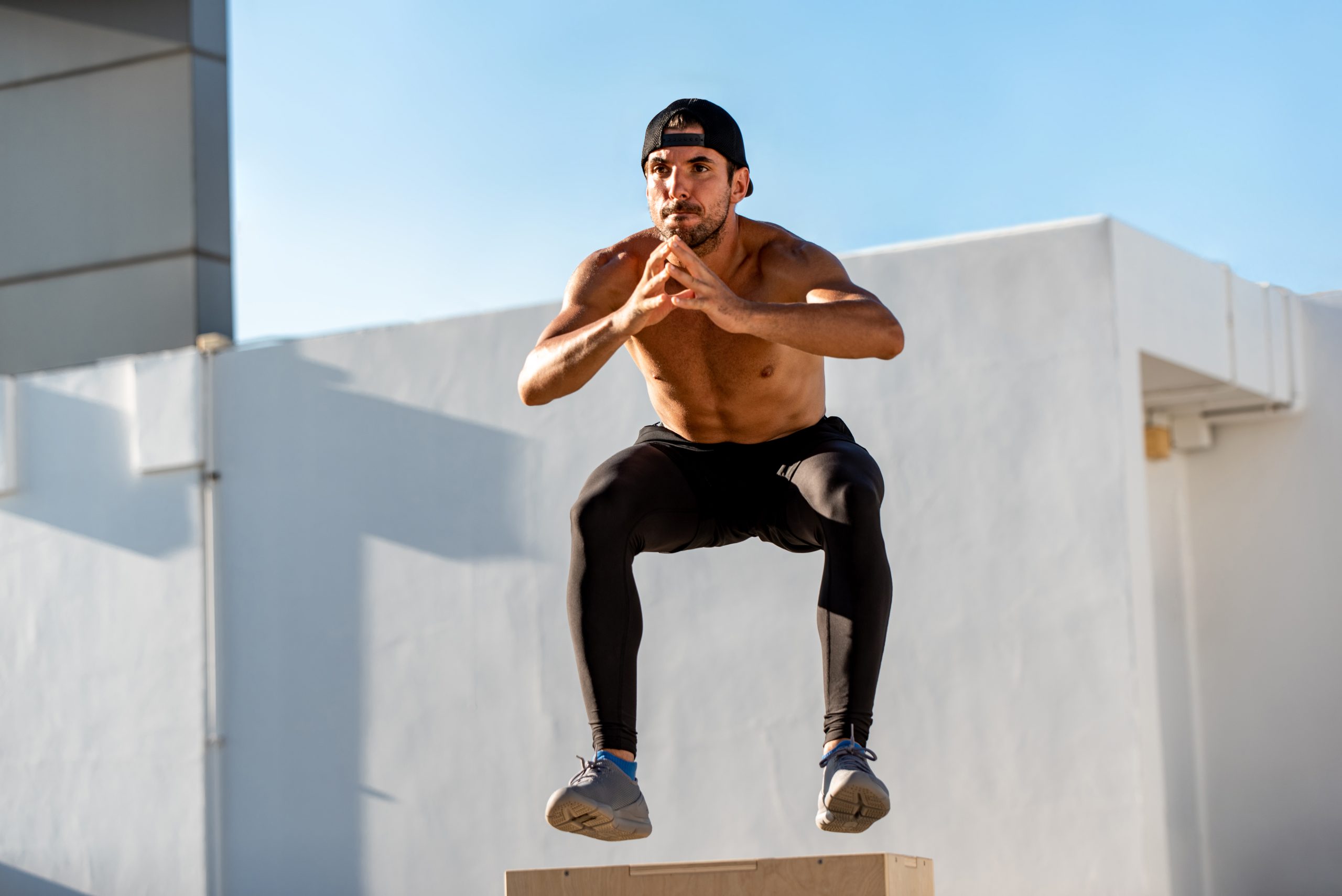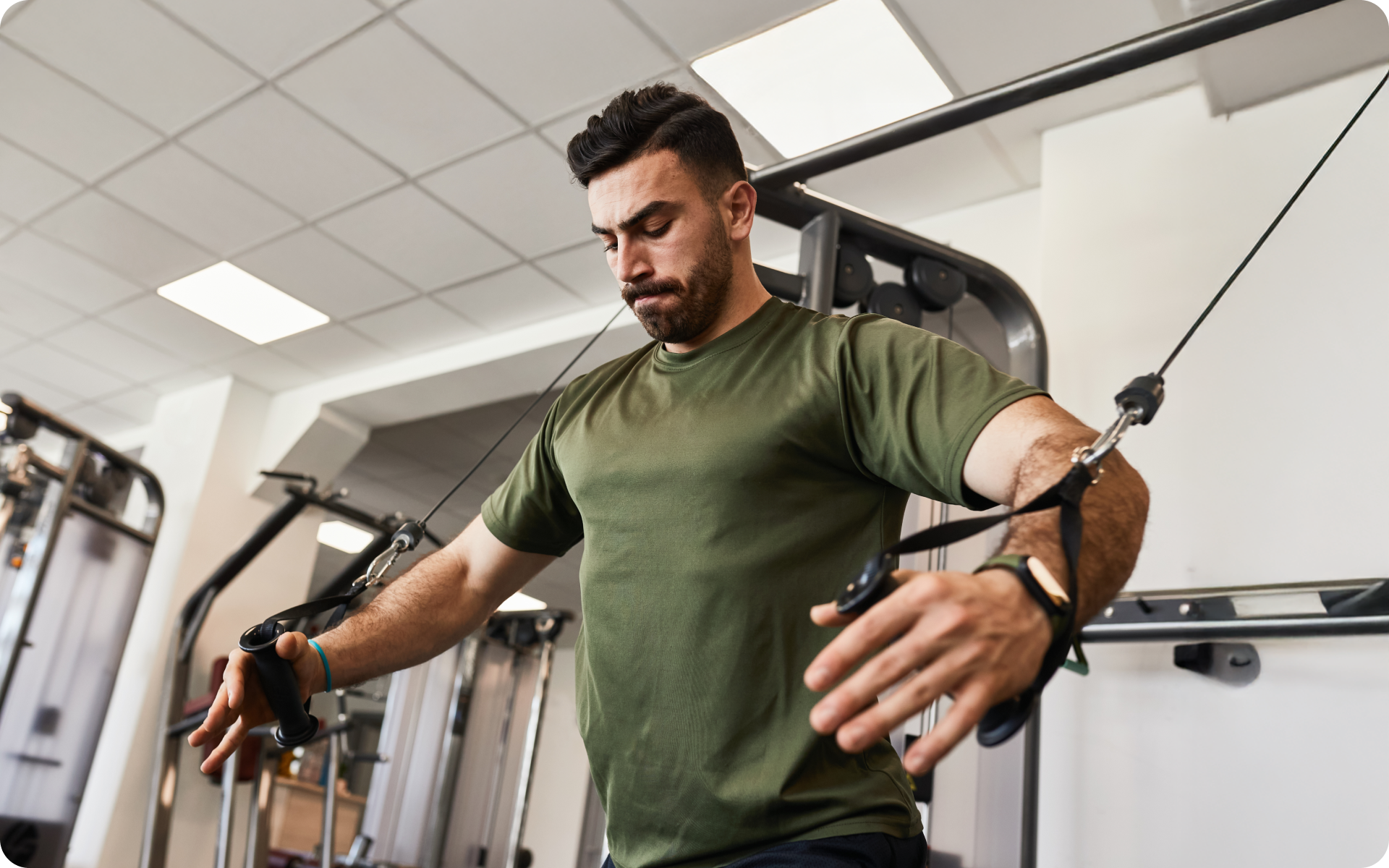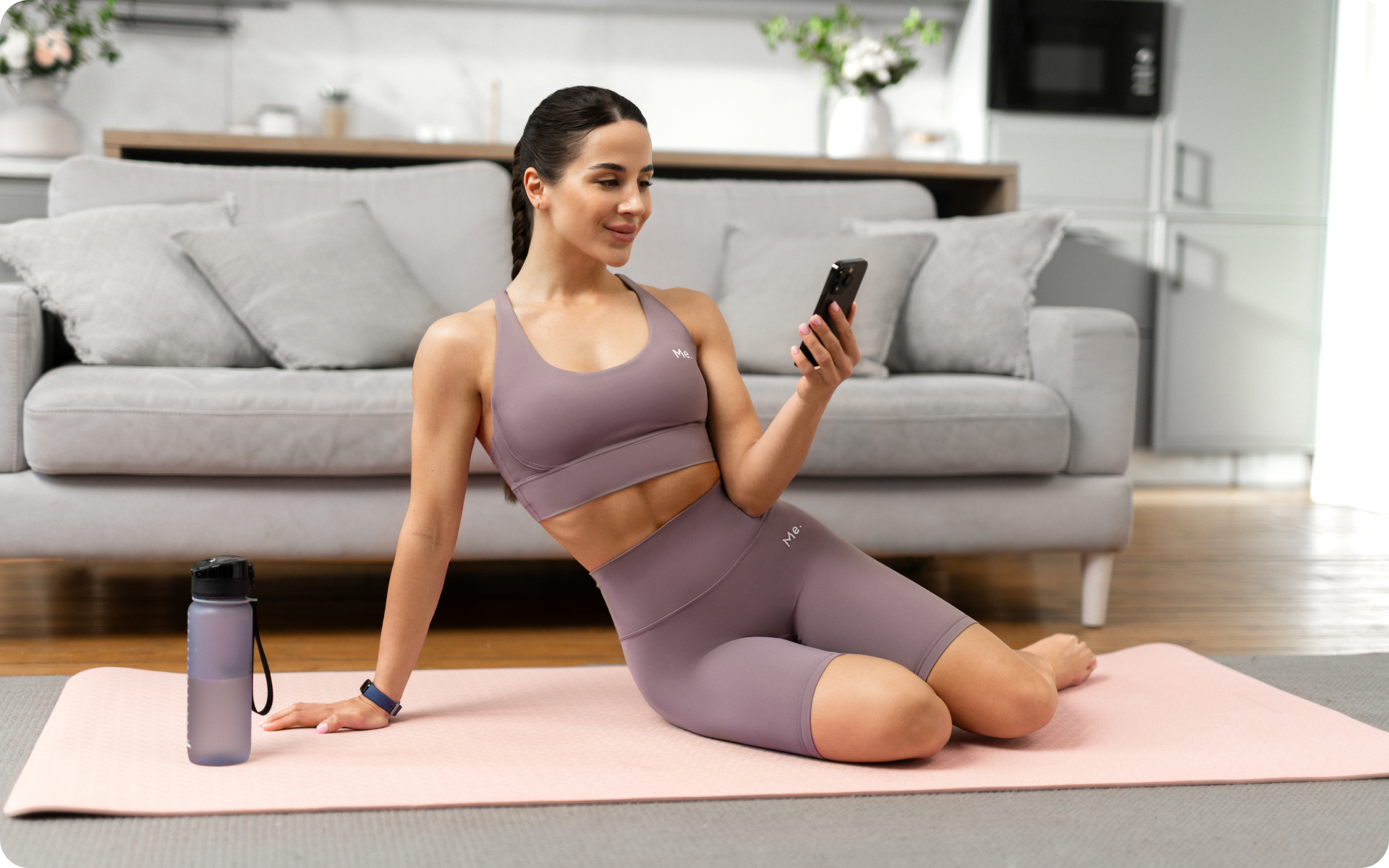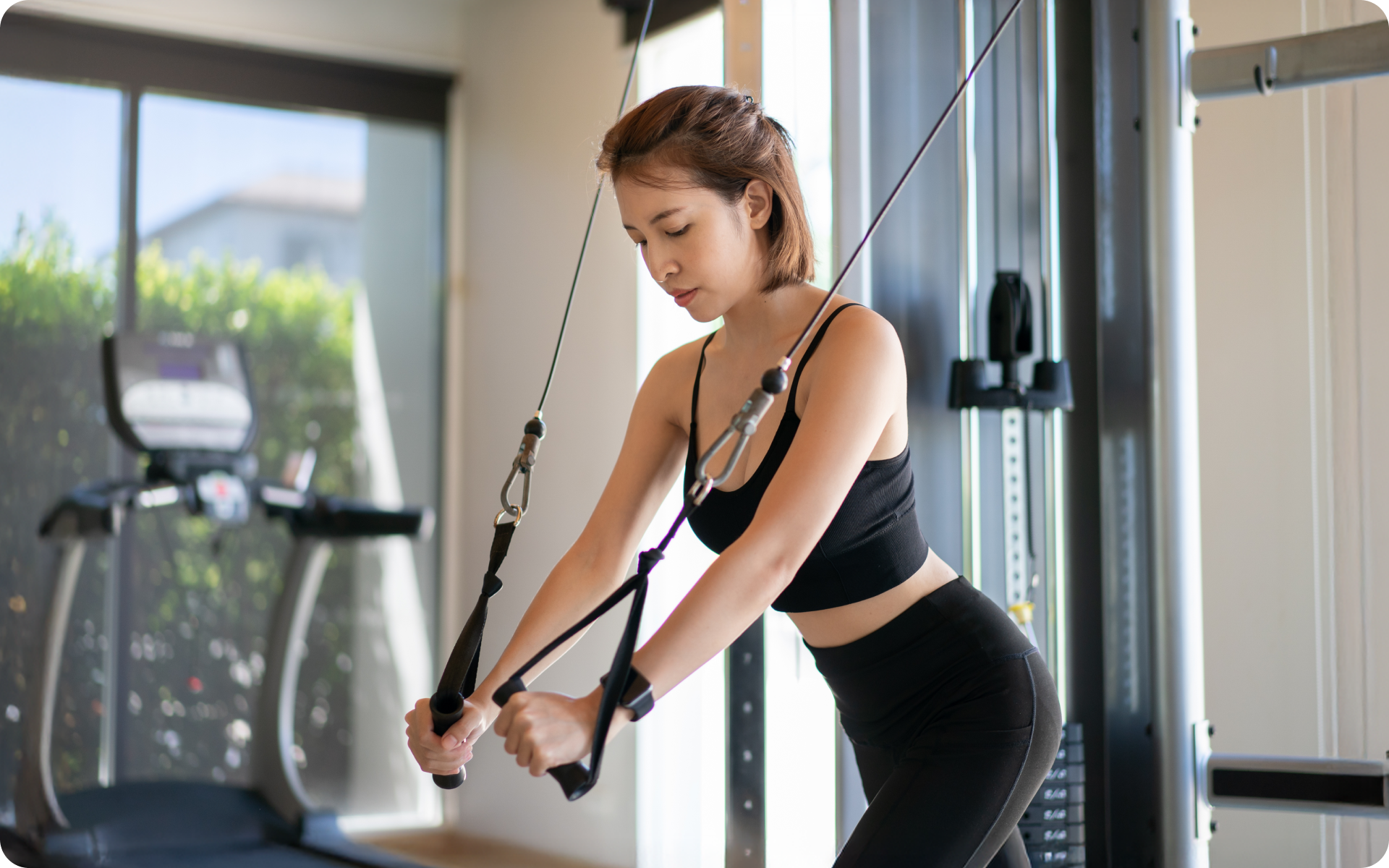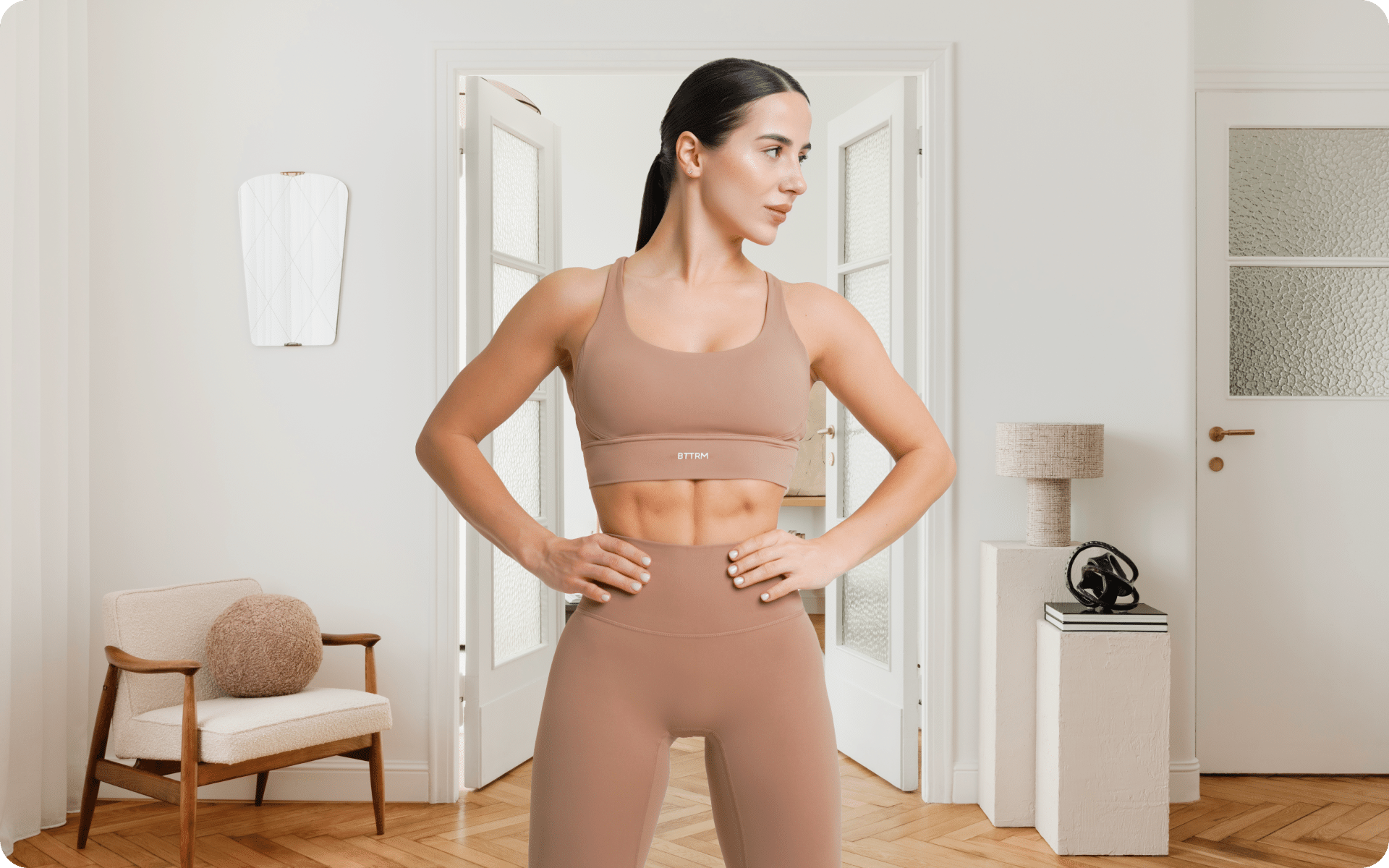If the word “jumping” makes you think of playing hopscotch or double-dutch, then you’ve got the wrong idea of plyometrics. Plyometric jumping is a powerful and explosive movement that can help athletes in many different sports enhance their performance.
Get your personalized
meal plan!
Plyometric movements are based on the principle of “stretch-shortening cycle” (SSC). This means that the muscle is first stretched (eccentric phase) and then contracts quickly (concentric phase) to produce explosive force.
The SSC is one of the most important mechanisms in human movement and plays a big role in things like sprinting, jumping, and throwing.
Plyometric training can help improve an athlete’s power, speed, and agility. It can also help reduce the risk of injury by improving the muscles’ ability to absorb impact (6).
If you’re thinking about adding plyometric training to your workout routine, here’s everything you need to know about why and how it works.
What Are The 3 Phases Of Plyometrics?
Plyometric training is a type of power training that uses the SSC to enhance an athlete’s performance (6). The SSC is made up of three phases: eccentric, amortization, and concentric.
Eccentric Phase
During the eccentric phase, the muscle is lengthening under load. This phase is also known as the “loading” or “stretch” phase.
The eccentric phase of a plyometric movement is important because it helps store elastic energy in the muscles (5). This stored energy is then used in the next two phases to produce explosive force.
For example, when basketball players jump to dunk the ball, they start in an eccentric position with their legs bent. This eccentric phase allows them to store elastic energy in their muscles, which they then use in the concentric phase to propel themselves up and into the air.
Amortization Phase
The amortization phase is also known as the “transition” phase. This is the brief period between the eccentric and concentric phases when the muscle is neither lengthening nor contracting.
During the amortization phase, the stored elastic energy in the muscles is converted into kinetic energy. This conversion of energy helps to explain why plyometric movements are so explosive. If this phase lasts too long, however, the stored energy will be lost and the explosive force will be reduced.
Read More: The Best Standing Core Exercises For Strength, Stability, And Function
Concentric Phase
The concentric phase is when the muscle shortens as it contracts. This is also known as the “explosive” or “power” phase.
In plyometric movements, the concentric phase is where all of the stored energy from the eccentric and amortization phases is released to produce explosive force. This is why plyometrics are often referred to as “power training.”
For example, when a basketball player jumps to dunk the ball, they use the stored elastic energy in their muscles to explosively propel themselves up and into the air. The concentric phase of the jump is what gives them the power to dunk the ball.
What Are Plyometric Jumps Good For?
Many benefits come from adding plyometric jumps to your workout routine.
1. Improved Athletic Performance
Athletes who do plyometric training can see improved power, speed, and agility. This type of training can help you run faster, jump higher, and change directions more quickly (3).
2. Enhanced Muscle Growth
Plyometric movements are based on the SSC, which is a powerful stimulus for muscle growth. Research has shown that plyometric training can lead to significant increases in muscle size and strength (7).
3. Reduced Risk Of Injury
Plyometric training can also help reduce the risk of injuries by improving the muscles’ ability to absorb impact. This is especially beneficial for athletes who play contact sports, such as football or hockey (5).
Plyometric jumping also increases joint stability which translates to a reduced risk of joint injuries.
4. Improved Bone Density
Bone density is another benefit of plyometric training (10). This type of training puts stress on the bones, which helps to stimulate new bone growth. This can help to prevent injuries and diseases, such as osteoporosis.
5. Increased Calorie Burn
Plyometric movements are very taxing on the body and can lead to an increased calorie burn both during and after the workout. This makes plyometric training a great way to lose fat and get in shape (1).
6. Improved Cardiovascular Health
Plyometric training can also improve cardiovascular health by increasing heart rate and blood flow (2). This type of training has been shown to improve VO2 max, which is a measure of the body’s ability to use oxygen during exercise.
7. Enhanced Coordination And Balance
Plyometric training can help to improve coordination and balance. This is because plyometric movements require the coordination of multiple muscle groups working together (3).
This type of training can also help to improve proprioception, which is the body’s awareness of its position in space (8).
BetterMe app will provide you with a host of fat-frying fitness routines that’ll scare the extra pounds away and turn your body into a masterpiece! Get your life moving in the right direction with BetterMe!
8. Greater Mental Focus And Concentration
Plyometric training can also lead to greater mental focus and concentration. This is likely because plyometric movements require split-second timing and coordination.
9. Improved Posture And Body Alignment
Plyometric training can also help to improve posture and body alignment. This is because plyometrics help strengthen the muscles that support the spine. Sitting and standing up straight will become easier, and you’ll be less likely to slouch.
10. A Fun And Challenging Workout
Plyometric training can be a fun and challenging workout. This type of training is unlike traditional weightlifting or cardiovascular exercise. Plyometrics offer a unique challenge that can help to keep you motivated and engaged in your workout routine.
Plyometric Jumping Techniques
There are many different plyometric jumping techniques that you can use to improve your athletic performance, muscle growth, and overall fitness.
Squat Jumps
Squat jumps are a simple yet effective plyometric exercise that work the quads, glutes, and calves. To do a squat jump:
- Start by standing with your feet shoulder-width apart.
- Lower your body into a squat position, then explosively jump up into the air.
- Land softly and immediately lower your body back into the squat position to prepare for the next jump.
Box Jumps
Box jumps are a great plyometric exercise for developing explosive leg power.
To do a box jump:
- Start by standing in front of a sturdy box or platform.
- Lower your body into a squat position, then jump up onto the box.
- Land with both feet on the box, then stand up straight and carefully jump back down to the ground.
Broad Jumps
Broad jumps are a plyometric exercise that work the quads, glutes, and calves.
To do a broad jump:
- Start by standing with your feet shoulder-width apart.
- Lower your body into a quarter squat, then explosively jump forward as far as you can.
- Land softly and immediately lower your body back into the quarter squat position to prepare for the next jump.
Reverse Lunge Knee-Ups
Reverse lunge knee-ups are a plyometric exercise that work the quads, glutes, and hamstrings. To do a reverse lunge knee-up:
- Start in a standing lunge with your left foot forward. Your right hand should be on the ground for balance.
- Explosively jump up, driving your right knee toward your chest and your right hand off the ground.
- As you land, return to the starting position.
- Repeat the movement for 30 seconds before switching sides.
Read More: 12 Of The Best Bodyweight Tricep Exercises
Lateral Jumps
Lateral jumps are a plyometric exercise that work the quads, glutes, and calves. To do a lateral jump:
- Start in a standing position with your feet shoulder-width apart.
- Jump to the right as far as you can.
- Land softly on your right foot and immediately jump to the left.
- Continue alternating sides for 30 seconds.
Burpees
Burpees are a full-body plyometric exercise that work the quads, glutes, chest, shoulders, and arms. To do a burpee:
- Start in a standing position with your feet shoulder-width apart.
- Lower your body into a push-up position.
- Quickly jump your feet forward so that you’re in a squat position.
- Explosively jump up into the air, reaching your hands overhead.
- Land softly and repeat the movement.
Clapping Push-Ups
Clapping push-ups are a plyometric exercise that work the chest, shoulders, and arms. To do a clapping push-up:
- Start in a push-up position with your hands shoulder-width apart.
- Lower your body down towards the ground.
- Explosively push up off the ground, propelling your body into the air.
- Clap your hands together before landing softly back in the push-up position.
Skater Jumps
Skater jumps are a plyometric exercise that work the quads, glutes, and calves. To do a skater jump:
- Start in a standing position with feet hip-width apart.
- From standing push off your right foot to leap on the left.
- Land on your left foot bringing your right foot behind your left leg. Aim to land softly with a slight bend in your left knee and keep your right foot off the floor.
- Pause for a beat, then leap in the other direction.
Betterme will keep you laser-focused on your weight loss journey! Nutrient-packed meal plans, fat-blasting workouts, galvanizing challenges and much more. Try using the app and see for yourself!
Plyometric Training Tips
Here are a few tips to help you get the most out of your plyometric training:
1. Start Slowly And Progress Gradually
Plyometrics are a high-intensity form of exercise, so it’s important to start slowly and increase the intensity of your workouts gradually.
2. Use Proper Form
Plyometric exercises place a lot of stress on the joints, so it’s important to use proper form to avoid injury.
3. Wear Supportive Shoes
Wearing supportive shoes will help to absorb some of the impact and protect your joints (11).
4. Warm Up Thoroughly
A thorough warm-up will help to prepare your muscles and joints for the high-impact nature of plyometric exercises (9).
5. Cool Down And Stretch Afterwards
A cool-down and stretch session will help to reduce muscle soreness and improve range of motion (4).
Plyometric training can be a fun and effective way to improve your athletic performance, muscle growth, and overall fitness. Use these tips to help you get the most out of your plyometric workouts.
The Bottom Line
Plyometric training is a great way to improve your performance in many different sports. Plyometric movements can help you run faster, jump higher, and change direction more quickly. They can also help you generate more power when throwing or hitting a ball.
DISCLAIMER:
This article is intended for general informational purposes only and does not serve to address individual circumstances. It is not a substitute for professional advice or help and should not be relied on for making any kind of decision-making. Any action taken as a direct or indirect result of the information in this article is entirely at your own risk and is your sole responsibility.
BetterMe, its content staff, and its medical advisors accept no responsibility for inaccuracies, errors, misstatements, inconsistencies, or omissions and specifically disclaim any liability, loss or risk, personal, professional or otherwise, which may be incurred as a consequence, directly or indirectly, of the use and/or application of any content.
You should always seek the advice of your physician or other qualified health provider with any questions you may have regarding a medical condition or your specific situation. Never disregard professional medical advice or delay seeking it because of BetterMe content. If you suspect or think you may have a medical emergency, call your doctor.
SOURCES:
- Body composition adaptations to lower-body plyometric training: a systematic review and meta-analysis (2021, ncbi.nlm.nih.gov)
- Cardiovascular responses to plyometric exercise are affected by workload in athletes (2013, ncbi.nlm.nih.gov)
- CURRENT CONCEPTS OF PLYOMETRIC EXERCISE (2015, ncbi.nlm.nih.gov)
- Do We Need a Cool-Down After Exercise? A Narrative Review of the Psychophysiological Effects and the Effects on Performance, Injuries and the Long-Term Adaptive Response (2018, link.springer.com)
- Effects of Plyometric Training on Muscle-Activation Strategies and Performance in Female Athletes (2004, ncbi.nlm.nih.gov)
- Effects of Plyometric Training on Physical Fitness in Team Sport Athletes: A Systematic Review (2016, ncbi.nlm.nih.gov)
- Effects of plyometric vs. resistance training on skeletal muscle hypertrophy: A review (2021, sciencedirect.com)
- The effect of a six-week plyometric training on dynamic balance and knee proprioception in female badminton players (2019, ncbi.nlm.nih.gov)
- The effect of warm-ups with stretching on the isokinetic moments of collegiate men (2018, ncbi.nlm.nih.gov)
- The Efficacy and Safety of Lower-Limb Plyometric Training in Older Adults: A Systematic Review (2018, link.springer.com)
- Wearing Cushioning Shoes Reduce Load Rates More Effectively in Post-Fatigue than in Pre-Fatigue during Landings (2021, mdpi.com)
